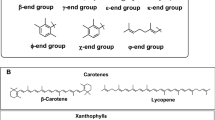Abstract
In cyanobacteria, phycobilisomes (PBS) act as antenna of the photosynthetic pigment apparatus. They contain brightly colored phycobiliproteins (PBP) and form giant supramolecular complexes (up to 3000–7000 kDa) containing 200 to 500 phycobilin chromophores covalently bound to the proteins. There are over ten various PBP known, which falls into one of three groups: phycoerythrins, phycocyanins, and allophycocyanins. Hollow disks of PBP trimers and hexamers are arranged into cylinders by colorless linker proteins; the cylinders are then assembled into PBS. Typical semidiscoidal PBS consists of a central core formed by three allophycocyanin cylinders and of six lateral cylinders consisting of other PBP and attached as a fan to the nucleus. The PBS number, size, and pigment composition in cyanobacteria depend on light conditions and other ambient factors. While PBSs have certain advantages compared to other antennae, these pigment-protein complexes require more energy for their biosynthesis than the chlorophyll a/b and chlorophyll a/c proteins of oxygenic photosynthetic organisms.
Similar content being viewed by others
References
Esenbeck, N., Über einen blau-rothen Farbstoff, der sich bei der Zersetzung von Oscillatorien bildet, Liebigs Ann. Chem., 1836, vol. 17, pp. 75–82.
Ikeuchi, M. and Ishizuka, T., Cyanobacteriochromes: a new family of tetrapyrrole-binding photoreceptors in cyanobacteria, Photochem. Photobiol. Sci., 2008, vol. 7, pp. 187–292.
Bykhovskii, V.Ya. and Zaitseva, N.I., Microbiological synthesis of tetrapyrrole compounds, Itogi Nauki i Tekhniki. Ser. Biol. Khim., Moscow: VINITI, 1989, vol. 32.
Glazer, A.N., Light guides. Directional energy transfer in a photosynthetic antenna, J. Biol. Chem., 1989, vol. 264, pp. 1–4.
Scheer, H. and Zhao, K.-H., Biliprotein maturation: the chromophore attachment, Mol. Microbiol., 2008, vol. 68, pp. 263–276.
Beale, S.I., Enzymes of chlorophyll biosynthesis, Photosynth. Res., 1999, vol. 60, pp. 43–73.
Stadnichuk, I.N. and Tropin, I.V., Antenna replacement in the evolutionary origin of chloroplasts, Microbiology (Moscow), 2014, vol. 83, pp. 299–314.
Frankenberg, N. and Lagarias, J.C., Biosynthesis and biological functions of bilins, in The Porphyrin Handbook, Kadish, K.M., Smith, K.M., and Guillard, R., Eds., Amsterdam: Academic, 2003, pp. 211–236.
Stadnichuk, I.N., Phycobiliproteins, Itogi Nauki i Tekhniki. Ser. Biol. Khim., Moscow: VINITI, 1990, vol. 40.
Apt, K.E., Collier, J.L., and Grossman, A.R., Evolution of the phycobiliproteins, J. Mol. Evol., 1995, vol. 248, pp. 79–96.
Zhao, F. and Qin, S., Evolutionary analysis of phycobiliproteins: implications for their structural and functional relationships, J. Mol. Evol., 2006, vol. 63, pp. 330–340.
Betz, M., One century of protein crystallography: the phycobiliproteins, Biol. Chem., 1997, vol. 378, pp. 167–176.
Adir, N., Elucidation of the molecular structures of components of phycobilisome: reconstructing a giant, Photosynth. Res., 2005, vol. 85, pp. 15–32.
Watanabe, M. and Ikeuchi, M., Phycobilisome: architecture of a light-harvesting supercomplex, Photosynth. Res., 2013, vol. 116, pp. 265–276.
Gannt, E. and Conti, S.F., Phycobiliprotein localization in algae, Brookhaven Symp. Biol., 1966, vol. 19, pp. 393–405.
Koller, K.-P., Wehrmeyer, W., and Mörschel, E., Biliprotein assembly in the disc-shaped phycobilisomes of Rhodella violacea, Eur. J. Biochem., 1978, vol. 91, pp. 57–63.
Tandeau de Marsac, N. and Cohen-Bazire, N., Molecular composition of cyanobacterial phycobilisomes, Proc. Natl. Acad. Sci. U. S. A., 1977, vol. 74, pp. 1635–1639.
Liu, L.-N., Chen, X.-L., Zhang, Y.-Z., and Zhou, B.-C., Characterization, structure and function of linker polypeptides in phycobilisomes of cyanobacteria and red algae: an overview, Biochim. Biophys. Acta., 2005, vol. 1708, pp. 133–142.
Stadnichuk, I.N., Phycobilisomes, Itogi Nauki i Tekhniki. Ser. Biol. Khim., Moscow: VINITI, 1991, vol. 46.
Pizarro, S.A. and Sauer, K., Spectroscopic study of the light-harvesting protein C-phycocyanin associated with colorless linker peptide, Photochem. Photobiol., 2001, vol. 73, pp. 556–563.
MacColl, R., Allophycocyanin and energy transfer, Biochim. Biophys. Acta, 2004, vol. 1657, pp. 73–81.
Engelmann, T.W., Über Sauerstoffausscheidung von Pflanzenzellen im Microspectrum, Bot. Z., 1882, vol. 40, pp. 419–425.
Rakhimberdieva, M.G. Boichenko, V.A., Karapetyan, N.V., and Stadnichuk, I.N., Interaction of phycobilisomes with photosystem II dimers and photosystem I monomers and trimers in the cyanobacterium Spirulina platensis, Biochemistry, 2001, vol. 40, pp. 15780–15788.
Grossman, A.R., van Waasbergen, L.G., and Kehoe, D., Environmental regulation of phycobilisome biosynthesis, in Light Harvesting Antennas in Photosynthesis, Green, B. and Parson, W., Eds., Dordrecht: Kluwer. 2003, pp. 471–493.
Everroad, C., Six, C., Partensky, F., Thomas, J.-C., Holtzendorff, J., and Wood, A.M., Biochemical bases of type IV chromatic adaptation in marine Synechococcus sp., J. Bacteriol., 2006, vol. 188, pp. 3345–3356.
Stowe-Evans, E.L. and Kehoe, D.M., Signal transduction during light-quality acclimation in cyanobacteria: a model system for understanding phytochromeresponse pathways in prokaryotes, Photochem. Photobiol. Sci., 2004, vol. 3, pp. 495–502.
Murata, N., Control of excitation transfer in photosynthesis, Biochim. Biophys. Acta, 1969, vol. 172, pp. 242–251.
Stadnichuk, I.N., Lukashev, E.P., and Elanskaya, I.V., Fluorescence changes accompanying short-term light adaptations in photosystem I and photosystem II of the cyanobacterium Synechocystis sp. PCC 6803 and phycobiliprotein-impaired mutants: State1/State2 transitions and carotenoid-induced quenching of phycobilisomes, Photosynth. Res., 2009, vol. 99, pp. 227–241.
Rakhimberdieva, M.G., Stadnichuk, I.N., Elanskaya, I.V., and Karapetyan, N.V., Carotenoidinduced quenching of the phycobilisome fluorescence in photosysten II-deficient mutant of Synechocystis sp. PCC 6803, FEBS Lett., 2004, vol. 574, pp. 85–88.
Kirilovsky, D. and Kerfeld, C.A., The orange carotenoid protein: a blue-green light photoactive protein, Photochem. Photobiol. Sci., 2013, vol. 12, pp. 1135–1143.
Keeling, P.J., The number, speed, and impact of plastid endosymbioses in eukaryotic evolution, Annu. Rev. Plant Biol., 2013, vol. 64, pp. 583–607.
Ajlani, G. and Vernotte, C., Construction and characterization of phycobiliprotein-less mutant of Synechocystis sp. PCC 6803, Plant Mol. Biol., 1998, vol. 37, pp. 577–580.
Severtsov, A.N., Morphological Regularity of Evolution, in Complete works, 1949, vol. 5, Moscow-Leningrad.
MacColl, R. and Guard-Friar, D., Phycobiliproteins, 1987, Boca Raton: CRC.
Eriksen, N.T., Production of phycocoyanin—a pigment with applications in biology, biotechnology, foods and medicine, Appl. Microbiol. Biotechnol., 2008, vol. 80, pp. 1–14.
Author information
Authors and Affiliations
Corresponding author
Additional information
Original Russian Text © I.N. Stadnichuk, P.M. Krasilnikov, D.V. Zlenko, 2015, published in Mikrobiologiya, 2015, Vol. 84, No. 2, pp. 131–143.
Rights and permissions
About this article
Cite this article
Stadnichuk, I.N., Krasilnikov, P.M. & Zlenko, D.V. Cyanobacterial phycobilisomes and phycobiliproteins. Microbiology 84, 101–111 (2015). https://doi.org/10.1134/S0026261715020150
Received:
Published:
Issue Date:
DOI: https://doi.org/10.1134/S0026261715020150




